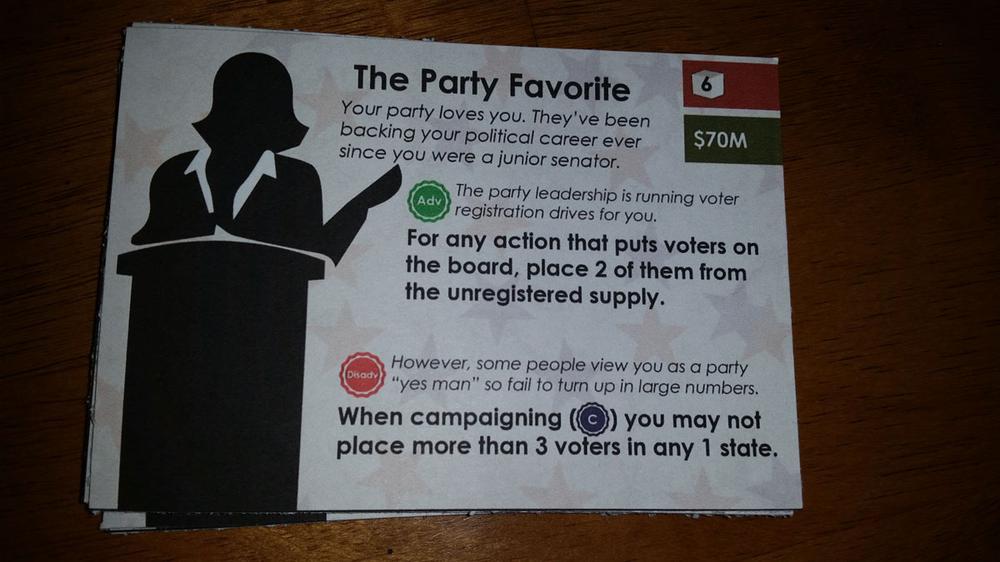
Campaign Trail is a new game currently seeking funding on Kickstarter that allows 2-6 players to compete to become the next President of the United States by trying to win the most votes in each state, thus ensuring an Electoral College victory come Election Day.
The game has about two weeks to go on its Kickstarter campaign, and by the looks of it should reach its funding goal. A copy of the regular version of the game can be had for a pledge of $49, while a $69 pledge gets you an upgraded Deluxe Edition.
Note: I was sent a prototype to test the game for review. The Kickstarter page already shows significant upgrades in artwork from my prototype, so the pictures below do not represent the current look of the game.
New to Kickstarter? Check out our crowdfunding primer.
Components:
– 1 Gameboard, showing a map of the United States
– 1 Debate Board
– 105 Action Cards
– 60 Money Cards
– 51 Scoring Tokens
– 10 City Tokens
– 15 Debate Cards
– 1 Scoring Track
– Candidate Cards
– 1 Reference Manual
– 1 Rulebook
How to Play:
The game requires a bit of time to setup, but several well-thought-out design features make it much easier than games I’ve seen of similar complexity. Place the board on the table, along with the scoring track and debate board (although the latter isn’t needed until about a third of the way through the game, so it can be set aside initially). Shuffle the candidate cards and deal two to each player. The players then select one of the cards to be their candidate, and the remainder are returned to the box. Each candidate has strengths and weaknesses. When playing the first time, it’s probably best to semi-randomly select a candidate, but once you have the game figured out you can take those strengths and weaknesses into account in formulating your initial playing strategy.

Place two voter tokens (small wooden cubes) in each state based on what’s indicated for that state. If playing with 2 or 4 players, you only distribute the blue (Democrat) and red (Republican) tokens. If playing with 3, 5 or 6 players, also distribute the white (Independent) tokens. The board setup is rather ingenious here–in each state, there’s a ribbon showing either a blue, red, or white star, indicating the initial control of that state. However, each banner also has a second star, which is used to determine ties (more on that later) but also provides a quick fallback for the 2 or 4 player setup. Thus, there’s no need to dig through the rulebook just to get started, which I particularly liked.
Once the cubes have been placed, you set up the scoring track. This is another of the very well-designed aspects of the game. The track includes three color-coded grooves, which the scoring tokens slide into. Those tokens represent each state and are all scaled based on the number of electoral votes that state has. This makes it very easy to keep track of how each candidate is doing during the game. The initial setup is based on who controls which state, but, again, while other games might rely on charts and whatnot buried in the rules, Campaign Trail makes this step easy, since you can simply refer to the board.

Players are given a number of starting registered voters and money based on icons on their candidate card.
The action cards are then shuffled and five are dealt to each player. The players then look at these cards and, based on an icon on the card, determine their starting state. They place their character meeple, their home state indicator, and two additional voters in that state. And right here, in the setup, is the first key strategic decision: do you choose as your home state a state your party already controls, and then strengthen that control with those two additional voters, or do you choose a state the other party controls, which then brings you to a tie in that state? Or, do you position yourself geographically, ready to quickly move into an important area to start campaigning?
The 4 and 6 player games are played in teams, one for each party (Democrat and Republican in the 4-player, Democrat, Republican, and Independent in the 6-player). The two players on the team decide amongst themselves who will be the presidential candidate and who will be the running mate, but there’s no real difference in gameplay between the two. In a 5-player game, one player assumes both roles and basically gets two consecutive turns each round. In a 2- and 3-player game, there are no running mates. According to the rules, the starting player is the one who most recently voted for something.
The game is played in a series of rounds, with each party taking a turn each round. Thus, in the team games, both players on the team take a turn one after another. They are free to determine the turn order within the party, and can change from one round to the next. Teammates are free to collaborate and share a pool of money and voters, but their cards are their own and cannot be shared at any time in the game.

On each turn, the player can choose one of up to six actions: travel, fundraising, register voters, advertise, campaign, or hold an event. The actions available to the player are determined by icons on their cards, and not all actions are available on all cards.
Travelling is the simplest of actions: you simply move your candidate a number of spaces (each state is a space) as indicated by the card you’re playing. Some cards allow you to fly between airports, letting you move across the country quickly. Fundraising is likewise easy—simply discard the card and collect the amount indicated. Registering voters is similar, requiring that you discard the card and collect the voters.
The other three actions are more complex and make up the bulk of the game. Advertising costs money—$20M per issue—but can be very effective over time. (I won my first game primarily on the back of repeated advertising campaigns.) The cards indicate a number of issues (icons) that are available for advertising, and the states in which those ads are run. After paying the money and discarding the card, you can place one voter from those you have registered into each state that matches the icon.
Campaigning is somewhat similar. The cards indicate a state, or more often groups of states, into which you can campaign. After paying a fee of $60M, you can place up to six voters into those states, to be distributed however you see fit. The catch is that you can only campaign if your candidate is in one of the states involved, which requires travel.
The final available action is an event. This involves playing a card and doing what the card says. Events may allow you to gain more votes or to launch an attack on your opponent. Most of the events are one-time things, but some are permanent—the card stays in front of you for the remainder of the game—while others are instant and can be played on other player’s turns.

About a third of the way through the game, the first of two debates occurs. This is the most abstract part of the game, but I felt it worked given the context. Debates are held in a predetermined city on a set of predetermined issues. Each candidate involved in the debate plays cards based on those issues, and after two rounds, the candidate who “won” the issue gains voters in certain states. The debates are quick, which is nice, but can often change things on the board rather dramatically. In 2- and 3 player games, everyone plays in both debates, while in the team games, the Presidential candidates participate in the first debate and the running mates in the second. (This is the only time when it matters which role you assume.)
Every time control of a state flips—anytime one party gets more voters (cubes) on a state than another party—that state’s scoring token is moved to the appropriate track. This way, you can always tell at a glance how everyone is doing.
The game ends after all of the cards have been played, at which point Election Day occurs. The party with the most votes wins and gets to move into the White House.
The Verdict
As a political junkie (I worked in politics for about eight years during and after college) and a board gamer, I’ve looked at a bunch of campaign games over the years, and I haven’t really liked any of them until now. Too often, they either relied far too heavily on luck, were just kind of silly, or both.
But Campaign Trails is the exception. It manages to really capture the feel of a campaign, with hard-fought battles in key states (you’re still never going to make it to Hawaii or Alaska) and a ton of really great strategy. A few of the elements of the game, particularly the issues and the debates, are abstracted quite a bit, but still make some sort of sense. The alignment of the issues to the states is well thought-out and matches the political realities of modern America, and while the debate doesn’t feel at all like a debate, the format in the game makes it quick and easy to get through and the end result—swaying voters based on issues—matches the goals of real debates.
What really sets Campaign Trails apart, not only from other political games but also a lot of games on the market in general, is the design. Even in the prototype, the components are obviously well considered, but from the pictures on the Kickstarter page it’s clear that the game’s designers have spent a lot of time and energy thinking about the visual components of the game. The score tracker is particularly cool and impressive. The very idea of tracking the score by these tokens, each one carefully scaled to represent the size of each state, is rather brilliant and by far one of the most elegant ways I’ve seen to track the scores in a game.
As an added bonus, the game provides tons of teachable moments, from providing a cool way to explain the Electoral College to talking about why issues are regional to examining the role that money plays in our electoral system.
In my time with GeekDad, I’ve tested quite a few games, which means that my family has tested quite a few. We’ve enjoyed most of them, but this is one of the first where my kids asked to play it again the following day. It’s a really great game. I’ve backed the game, and plan to give copies to friends as gifts. I can’t wait to see the finished product, and wholeheartedly recommend you back it as well. You’re not likely to be disappointed.


